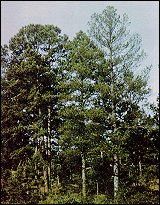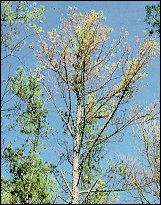
Importance: Littleleaf disease is the most important disease affecting shortleaf pine in the South. Loblolly pine is also affected, but to a lesser degree. Affected trees may die a year or two after the first symptoms or it may last as long as 12 years or more. On average, the tree will live six years.
Identification: Littleleaf disease is caused by the fungus Phytopthora cinnamomi. Several factors contribute to the disease complex including: low soil fertility (mainly nitrogen deficiency), heavy clay soils or soils with a hardpan, poor soil drainage, and the presence of nematodes and the Pythium fungus. Historically, shortleaf pine growing on highly eroded soils in the Piedmont have been the most effected by the disease. The fungus has a swimming spore stage that infects fine root hairs when soil remains wet for a long time from holding water or a high standing water table. Lack of a good root system to absorb nutrients and low soil fertility prevents trees from getting nutrients for good growth. The disease typically appears at age 20 years old or older, when demand for nutrients and water is greater.
Landowners may recognize littleleaf disease when needles of shortleaf or loblolly pine trees turn yellowish-green. Diameter and twig length growth slows down. Slow twig growth is noticeable, as needles bunch up at branch tips that have stopped growing. These needles are also shorter than normal. An abundant crop of cones, known as stress cones, is a characteristic disease symptom. These symptoms may be seen in various stages and combinations on different trees. Each tree seems to be affected individually, and it is common to see healthy looking trees adjacent to and interspersed with diseased trees. Trees that die from littleleaf disease usually have a great number of stress cones on the tree after needles have fallen.
Stands with littleleaf disease problems are likely habitats for low populations of southern pine beetles (SPB) between outbreaks. These areas often are first to develop large populations when an SPB epidemic begins, and the amount of damage during an epidemic is severe.

Shortleaf Pine and Fire: Alabama Forestry Commission research reveals an important relationship between wildfire and littleleaf disease. Shortleaf pine is unique among Alabama's pines because of its capacity to sprout consistently from the base when the main stem of a young tree is damaged. This occurs as the seedling bends over or crooks when it is about 2 to 3 inches tall. When it resumes vertical growth, the part on the ground is covered with soil and litter. If the area burns and the top is killed, some buds protected by the soil will sprout and one will become the dominant stem. In the absence of fire, buds remain dormant and the tree loses ability to sprout when it is about 10 years old. Implications of research are that a shortleaf pine developed from sprouting is less vigorous and more susceptible to littleleaf disease. Therefore, it is unwise to prescribe burn young shortleaf pine on high hazard littleleaf disease sites.
Prevention: Prevention of littleleaf disease requires knowledge of site index or site quality, species present, size distribution, insect and disease conditions, markets, and landowner objectives. The following prevention strategies are based on common landowner situations in Alabama. Prevention can be accomplished by species manipulation or site rehabilitation.
Low Site Index - Littleleaf disease is usually found on highly eroded soils with a site index at age fifty of 50 - 65 feet. This is a very low site index, indicating the site will produce less than an average amount of marketable products. These sites probably will not justify expense of artificial regeneration. If there are enough healthy trees of all species, retain them while cull and diseased trees are salvaged or thinned. Maintain stocking and naturally regenerate, even if it means seed tree regeneration with a component of shortleaf pine in the next generation. Thin or remove this species in the next rotation before it reaches age twenty.
Poor Site with Poor Stocking - On a very poor site with a low density of shortleaf pine and other quality trees for natural regeneration, it may be best to salvage everything of value and abandon intensive management. Over a long time period, soil conditions will improve. These lands could be targeted for deer and turkey management, recreation and non-game wildlife.
High hazard Sites - On typical high hazard littleleaf disease sites of highly eroded, low fertility clay, with a large component of shortleaf pine and an adequate combined stocking of all species, the stand may be managed as follows:
- In stands with few diseased trees, harvesting may be light and timed at ten-year intervals.
- In stands with 10-25 % of trees diseased, remove diseased trees on a six-year cutting cycle.
- In stands with more than 25% of trees diseased, cut shortleaf pine as soon as merchantable.
- Where littleleaf disease is causing important losses on shortleaf pine, plan cutting operations to favor loblolly pine or other more resistant species.
High Site Index - On site index over 70, it is common to clear cut and artificially regenerate a less susceptible species, usually loblolly pine. With proper spacing and timing of regeneration, expect good survival and a well-stocked stand. These advantages are achieved at higher costs than natural regeneration, an alternative which should always be evaluated.
All Clay Sites – Avoiding soil compaction and gully formation on clay sites will reduce risk of littleleaf disease. Avoid skidding and repeated use of trails on wet clay. On dry clay soils, disperse skid trails so no trail becomes compacted. Treat trails on slopes with water diversion structures such as water bars and seeded grass.
Clay/Hardpan – To determine whether a site has a clay or hardpan, utilize the county’s soil survey or check using a soil probe while conducting a site visit. If a clay/hardpan is found, subsoil/rip these sites in order to break this restrictive layer. This will permit better drainage and reduce the spread of the fungus. Conduct subsoiling/ripping during the summer months when the soil is dry. This will allow for the rips to close prior to planting season.
Poor Fertility – When soil tests have been conducted and the results show a nitrogen deficiency, fertilization can be conducted. If the stand structure allows, the landowner can plant legumes throughout the stand and this will yield short term increases in available soil nitrogen. Alternatively, the land owner can fertilize with one ton of 5-10-5 plus one half ton of ammonium sulfate per acre for tracts with high value trees or ornamental trees. The latter type of fertilization can postpone the development of littleleaf symptoms for up to 4 years. Trees will appear to have recovered during this period.
Photo Credit: USFS
Additional Resources